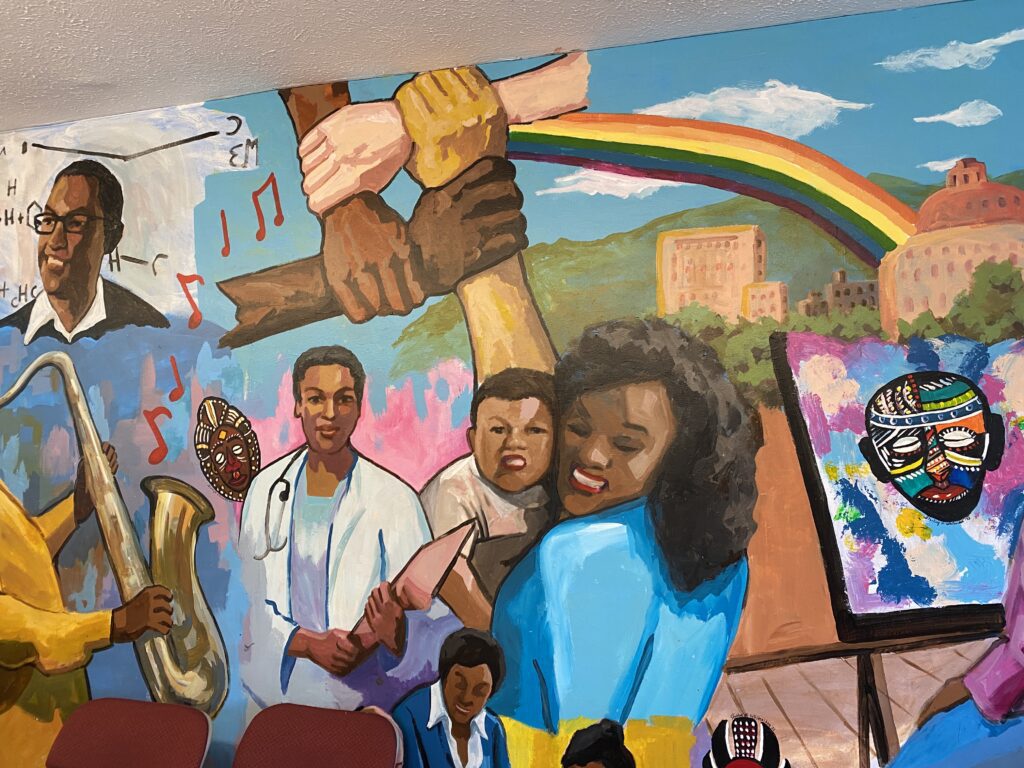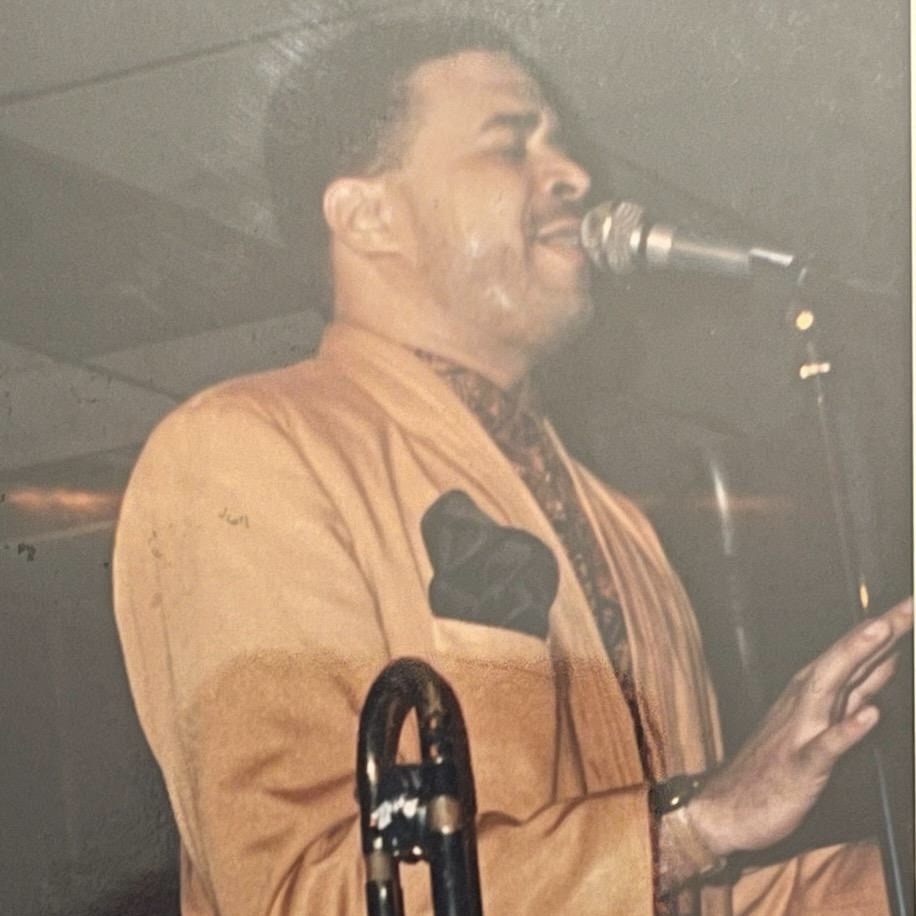|
|
In a basement across the street from Asheville Middle School, a band of six ready themselves for practice. On the saxophone is eighth grader Trinity Wilson, on the trumpet is third grader Johnnie Rush, and on the trombone is fifth grader Akari Rowe.

The other musicians performing with the band played while in school — but that was a couple of short decades ago. Accompanying these young brass players are seasoned professionals — Anthony Turner, Clifford Cotton II, and Gary Bradley, who have played with the likes 0f General Johnson, Dolly Parton, and The Temptations.
On the floor above the band room, students are painting with water colors or practicing their dance number. The walls are covered with murals of jazz musicians and local Black historical figures. Tables are topped with supplies, and shelves are filled with books and finished art projects.




Behind the reception desk sits a student-made mural, depicting the Land of Sky that at one time hung at the North Carolina Museum of Art. Before the band started in the basement, a drum circle formed on the front porch.

This is a typical weekday at the Delta House — art in all its forms is found in every corner, in every room.
History of the Delta House
The Delta House is a 21st Century Community Learning Center, a place for first through eighth graders to come after school for academic support and enrichment opportunities. They launched their program, called LEAAP for Success, in 2010. It stands for “Learning through Extended Academics and Arts Program.”
Shirley Whitesides is a member of the Delta Sigma Theta sorority, the group that opened the house in 1983. She was an original board member and still sits on it today as chairman. She estimates that over 5,000 Asheville students have come through the house’s programming over the years.

Helping students when they get out of school so they’ll be prepared for the next day is a baseline goal for Whitesides and the Delta House.
In “our program, we try to serve the whole child,” Whitesides said.
“We help them academically, we help them with social and emotional skills. We provide enrichment, and we have parent involvement. Parents must participate in the activities that we plan, and we provide services for the parents.”
Shirley Whitesides, president and chairman of the board at the Delta House
The Delta House also operates in Asheville Middle School across the street. That location serves sixth through eighth graders and focuses primarily on academics and tutoring. For both locations, the program runs Monday to Friday.
Currently, four Delta House alumni work for the organization, and countless others are employed in Asheville City Schools.
Students arrive by bus or walk over from the school to the Delta House, and from 3:30 to 4:00 p.m., it is their time to decompress. From 4:00 p.m. to 5:00 p.m., the focus is academics, and from 5:00 p.m. to 6:00 p.m., the students participate in art, STEM, cultural, or project-based learning enrichment.
Painting, dancing, cooking, and more — it is all available.
“It’s not only visual arts — it’s music, drumming, poetry. Everything that we can provide (to) help the kids feel successful,” Whitesides said.
The Delta House partners and collaborates with local and regional organizations to better serve their students, too. While the jazz band was playing in the basement, the Partnership for Appalachian Girls Education (PAGE) was upstairs giving the dancers flowers from their previous week’s performance. PAGE is also working with some students at the Delta House on an oral history project.

Whitesides believes students don’t realize how art can make them feel better, but as a retired educator who taught for 34 years, she does.
“Art is important to everybody,” she said.
In the last segment of the day, from 6:00 to 6:15 p.m., students are encouraged to journal or take some space for themselves before heading home.
“I do know the arts have saved lives, and when you integrate academic subjects with art, kids make connections because art is related to everything, the way I see it.”
Shirley Whitesides, president and chairman of the board at the Delta House
Currently, the Delta House has around 75 students who come daily. Once the school year ends, they will begin summer enrichment programming. This looks a little different as students come at least three to six hours a day, four days a week. The focus is project-based learning with a lot more field trips.
Intergenerational transfer of knowledge
Whitesides was there for the Delta House founding, and when we visit, she sits among the musicians in the basement. Students are pressing the older players to share some experience, and there is an audible gasp when Bradley, who students know as Mr. B, tells them he’s played with Ray Charles.

Whitesides believes in the intergenerational transfer of knowledge, and with the Delta House having existed for 40 years, there is a lot of wisdom and life experience to share.
Bradley used to teach at Asheville Music School. He has played backup for Dolly Parton, James Ingram, and Ray Charles, among others. He is on the keys this day because a student is out, but is seasoned on many brass instruments.

Turner, who before band practice in the basement was leading the drum circle upstairs, is a vocalist at heart, but picked up an instrument to help teach students. Also a retired educator, he sang with “The Showmen” and General Johnson from “Chairmen of the Board.”



Cotton is an Asheville native and legend in the music community. He attended Stephens-Lee High School, the only public high school that was dedicated to the education of African American students in Buncombe and surrounding counties.



While at Stephens-Lee, he and some classmates formed a band called “The Untils.” They went from playing at the school’s talent show to the City Auditorium, where stars like Fats Domino and Little Richard were performing at the time. Cotton’s musical journey — which he has spoken about in a conversation with The Buncombe County Library — has taken him all over the nation.
He joined “The Temptations” on tour right after their hit song “My Girl” started topping the charts, then went onto perform and tour with Dick Clark’s “American Bandstand.” He met Smoky Robinson, and he saw Motown move from Detroit to Los Angeles and moved with it. Now he finds himself back home, sharing his talents with the next generation of Asheville musicians.

Whitesides tells the students in the basement that the history and experience in the room is something to behold, shaking her head in amazement. She herself also embodies these two elements, and everyone who has come through the Delta House has benefited from her continued involvement.

Whitesides being in the school district for 34 years helped strengthen the relationship between the system and the Delta House. They have a memorandum of understanding, and her constant participation in both created a seamless transition for students and their parents. They trusted her in her classroom, so it’s easier to trust her in the Delta House.
She is still a practicing artist, and leads a lot of projects for the after school program. Her artwork is shown around town. A mixed-media project of hers was hanging at Central United Methodist Church when we visited.



“Art is — I look at it as a magical wand,” she said. There are no right or wrong answers when it comes to art, and students put in effort and can experiment. “The key is getting kids to make connections with the real world.”






